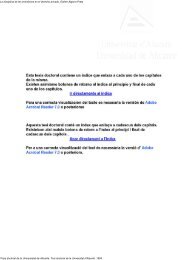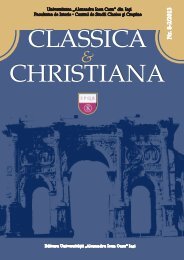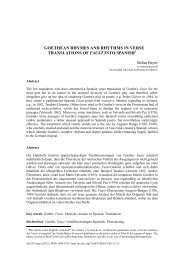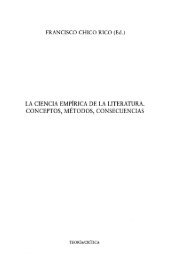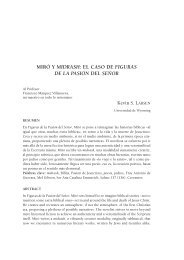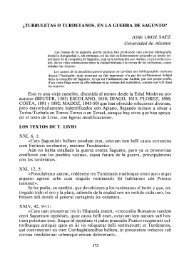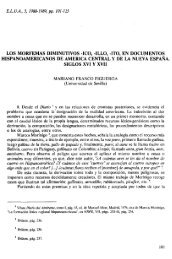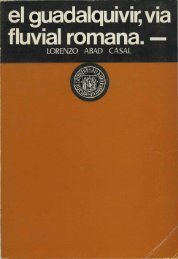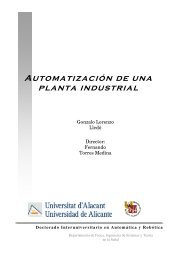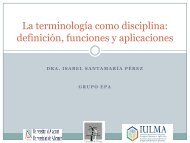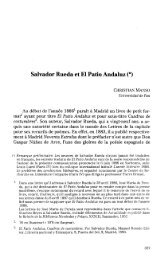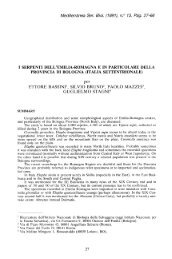ecological effects of marine protected areas empafish project ...
ecological effects of marine protected areas empafish project ...
ecological effects of marine protected areas empafish project ...
Create successful ePaper yourself
Turn your PDF publications into a flip-book with our unique Google optimized e-Paper software.
EMPAFISH Booklet no. 1 Ecological <strong>effects</strong> <strong>of</strong> Atlanto-Mediterranean MPAs in the EU<br />
The sheltered bays around the site provide resting and feeding <strong>areas</strong> for<br />
groups <strong>of</strong> waders and some other waterbirds that winter in Faial. Rarities from<br />
far-<strong>of</strong>f regions are also regularly recorded in the area.<br />
96<br />
o Marine mammals<br />
Descriptive and some quantitative work on cetacean assemblages in this area<br />
started in 1998 (e.g. Tempera et al. 2001c, 2001d). As a result <strong>of</strong> that work,<br />
focus was put in the ecology <strong>of</strong> bottlenose dolphins (Tursiops truncatus)<br />
within and outside the area. Work has been developed in the study <strong>of</strong> the<br />
population structure, residency, distribution and habitat preferences <strong>of</strong><br />
bottlenose dolphins in the area (Seabra et al. in press; Silva et al. 2005, in<br />
press). Although the main focus is in the bottlenose dolphin, distribution and<br />
habitat preferences are also being evaluated for other cetacean species<br />
occurring in the area.<br />
� Reserve effect<br />
o Fish assemblage<br />
The UVC monitoring program has shown that the diversity within the Monte<br />
da Guia reserve is higher than in any other habitat group in the island (Afonso<br />
2002; Tempera et al. 2002b). Some species also seem to have responded to<br />
the <strong>effects</strong> <strong>of</strong> protection, namely an increase in abundance and size <strong>of</strong><br />
parrotfish and groupers in the last 5 years, although other species that are<br />
legally or illegally exploited within the reserve do not seem to show the same<br />
patterns. The two shallow bays fringing the reserve are amongst the best<br />
examples <strong>of</strong> the role <strong>of</strong> this kind <strong>of</strong> habitat as nursery <strong>areas</strong> for a variety <strong>of</strong><br />
<strong>marine</strong> fishes (e.g. Santos et al. 1994; Santos et al. 2005). Additionally, the<br />
<strong>of</strong>fshore reefs within the future Channel Marine Park harbour a specific<br />
assemblage, where benthic and pelagic species coexist in large numbers<br />
(Afonso 2002). Furthermore, recent movement studies are also showing that<br />
these act as summer spawning aggregating sites for several pelagic<br />
predators, such as yellowmouth barracuda, white trevally, and amberjacks<br />
(Afonso et al. 2006).<br />
The sum <strong>of</strong> these habitats and the rich assemblages within it turn the Marine<br />
Park into a pivotal structure in the conservation efforts <strong>of</strong> the region to<br />
protect representative species and habitats and manage coastal resources<br />
(Santos et al. 2005; Tempera et al. 2001d).<br />
o Benthic assemblage<br />
Sub-littoral assemblages <strong>of</strong> Monte da Guia were recently surveyed using a<br />
physiognomic approach in the scope <strong>of</strong> <strong>project</strong>s Maré, Marov and Maya. This<br />
information has been instrumental for producing an inventory <strong>of</strong> benthic<br />
assemblages characterizing the rocky bottoms <strong>of</strong> the MPA and shall provide a<br />
reference for future monitoring. The same information is relevant for



